President's Message
Recently, while doing the long overdue task of organizing files, I couldn't help but read about some of the society's past. Just as when cleaning out drawers and finding old photographs, I reminisced about past projects and adventures. Wonderful trips: "Victory in Yorktown" for the 225th anniversary of the defeat of the British; Jamestown to visit the newly built Archaerium building for the 400th anniversary of the founding of Jamestown; Lincoln's Cottage and the Ford Theatre; Charles Town/Harper's Ferry during the sesquicentennial commemoration of the American Civil War. (We also visited the casino there, and just about everyone was a winner.)
While perusing the files, I also thought of dedicated members (some of whome were charter members) no longer with us: Margaret Thistlethwaite, who took me under her wing when I first joined the Society; Sue Krimm and Margaret Childress established the cemetery committee and referred to themselves as "The One Foot in the Grave Committee"; Arline Dowdy and her husband Nauman who rode on behalf of HCHS in a Rolls Royce car, on loan to HCHS for the Glen Allen Day Parade. Arline took on the task of researching genealogy, long before Ancestry.com and the internet. She did it the old fashion way, searching files at the courthouse and the libraries, searching cemeteries, family bibles and other means. John Ayers and Dudley Lanthrip were bust buddies. You hardly saw one without the other, along with Sandy, Dudley's wife. John served for many years as Treasurer. I believe he sent in the application to the IRS, establishing the Society as a 501(c)3 tax exempt charitable organization. Dudley took over as Treasurer and John served as Director of the Varina District.
I knew they were up to something when I saw Margaret Thistlethwaite and Arline Dowdy with their heads together looking in my direction. Before too long, they asked me, "How would you like to be Second Vice President in charge of membership?" Without waiting for an answer, I was elected.
Always one to jump right in, one of the projects I did was to distribute a membership survey. There were questions about suggestions for speakers, programs, tours; suggestions for fundraisers and other opinions. I am pleased to report that we have accomplished the majority of the suggestions over the years. The date was April 14, 2005. Perhaps it is time for another survery?
Later after being elected President, one of the first projects was the saving of Nuckols Farmhouse from development. I was reeled in, hook, line and sinker. What a wonderful feeling it was and is to save history!
I am enjoying reading about the interesting people I have met and worked with; the wonderful meetings, speakers, and the many locations we have visited. I think it will take me much longer than I thought to complete the project of organizing files.
I would like to take this opportunity to thank those of you who have taken up the torch in the footsteps of those who came before. I found the following anonymous verse in my notes:
The torch has been lighted
'Twas lighted long ago
By brave and fearless men
They kept the light aglow
It's our task to keep it burning
Burning clear and bright
That men who travel onward
May be guided by its light.
from the History of Deep Run Church
Sarah Pace,
President
>Back to Top<
March Meeting
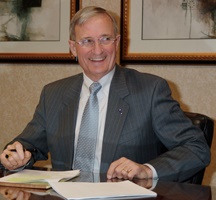
Our speaker will be Charles "Chuck" Payne. A former Lakeside resident, he is a retired attorney and author of 11 books. His latest 5-star acclaimed book, Chris, The True Story is an inspiring true story about hs mother's struggles over adversity working as an auto mechanic in mid-twentieth century Richmond. He will also speak about the time leading up to and after WWII and will answer the question, "What made America's Greatest Generation?"
The meeting is Sunday, March 3rd at 2:30PM. From Sandston, take Route 6 (Williamsburg Road) east and turn right at the stoplight at Elko Road. The Antioch School Community Center will be on the right.
>Back to Top<
A New Centenarian - Happy 100th!

Bob Bluford celebrated his 100th birthday on December 4, 2018. Bob was president of our Society from 1991 to 1993 and has spent a lifetime in preservation efforts. Among his many triumphs, he is the founder of the Historic Polegreen Church Foundation and site in Hanover County. Bob's daughter, Jeanne Bluford, reports that he is doing well and living in Henrico. Congratulations, Bob, on your 100 years!
>Back to Top<
Inventive Henricoans

For our series on inventive Henricoans of the past, we pick up on a subject related to this issue's article on the locomotive Henrico. Sparks thrown off by nineteenth century trains posed problems for the areas through which the train traveled and to those passengers in cars behind the locomotive. Spark arresters inside the locomotive's stack mitigated the problem; and in 1879, T. Allan Talbott of Henrico offered an improved design.
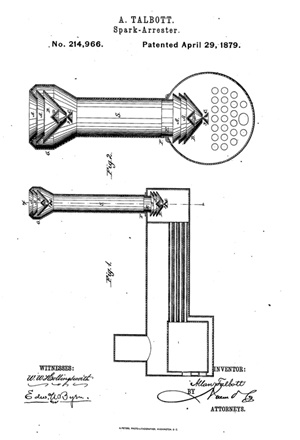
According to his patent application, his arrester operated as follows:
The gas, smoke, and sparks, as they pass from the boiler, are drawn rapidly through the annular spaces formed by the ring or rigs and bottom B, and are turned downward; but the sparks, being heavier than the current of gas or smoke in which they are traveling, are thrown down into the bottom B, and as there is no countercurrent to lift them they pass through the openings at x and y. Should they by chance, after passing out at x and y, be again taken up by the current, they will again be deposited in the bottom B, and this will be repeated until they are entirely consumed or extinguished.
>Back to Top<
Locomotives on the Richmond and Petersburg Railroad Included The Iron Horse Henrico
Over the course of its history, Henrico County has lent its name to a number of interesting vehicles. In the very early nineteenth century, the two-masted square-rigged brig Henrico cruised the Atlantic and Pacific. The attack transport USS Henrico saw action in World War II, Korea and Vietnam. And then in the 1950s, passengers on the RF&P could take their meals in the dining car named Henrico.
1852 saw another conveyance with the name Henrico join the group. The Richmond Dispatch of 30 June headlined "New Locomotive," made the following announcement: "Yesterday, by means of an artificial wooden track laid in Cary Street a new and splendid locomotive, called "Henrico," was conveyed from the iron foundry and manufactory of Messrs. Burr & Eddinge [sic], to the Petersburg depot. It will ply on the Petersburg railroad. It was a notable and gratifying specimen of Southern manufacturing skill."
David J. Burr had opened a Richmond foundry around 1820 and advertised his ability to produce steam engines, tobacco presses, corn crushers, bells, and various brass and iron goods. From 1849 to about 1855, he ran the machinery business Burr and Ettinger, cited in the Richmond Dispatch announcement, and produced a few locomotives including the Henrico. According to Marvin Broyhill's "The Antebellum Railroads of Petersburg, Virginia", the Henrico was the Richmond and Peterburg's primary gravel-hauling locomotive. And it was apparently quite heavily used, logging 10,533 miles in 1861 and 11,330 miles in 1862.
The 17.5-ton Henrico was the type of locomotive known as a 4-4-0, a name indicating an arrangement of four leading wheels on two axles, usually in a leading bogie (or undercarriage), four powered and coupled driving wheels on two axles, and no trailing wheels. No pictures of the Henrico or any of the other locomotives from Burr & Ettinger have been identified.
Although Marvin Broyhill points out the locomotive's role in hauling gravel, the Henrico, it seems, was much more versatile; and like everything mechanical, it was not without its breakdowns. The 12 March 1856 Daily Dispatch ran a brief article headlined "A Blow Out." It noted that "The locomotive 'Henrico,' on the Petersburg and Richmond railroad, blew out its cylinder head Monday morning while on its way to Richmond with the passenger train." But that wasn't the end for the Henrico."
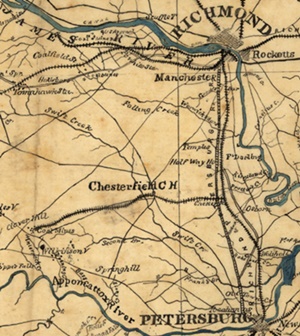
At left, south central Virginia rail lines. The Engineer Bureau of the War Department created an 1864 map. This detail shows the Richmond and Petersburg Railroad line.
The Civil War came, and although the Henrico's role in the war is not documented, the Richmond and Petersburg Railroad was significant in transporting goods and personnel during the conflict; and certainly the Henrico played a part. After the war, however, we do know that the locomotive played a part in Richmond's recovery from the war's destruction. In fact, in the James River just downstream from the Manchester Bridge, we can see what remains of where the locomotive played that part - the stone piers that supported the Richmond and Petersburg Railroad bridge.
Retreating Confederate forces burned the bridge in 1865; and the bridge was rebuilt a year later, inspiring an excursion trip to celebrate the event on a rainy day that the Daily Dispatch of 28 May 1866 colorfully claimed made the river look "colder, deeper, and wetter than ever, and as for pine woods and thickets - wheugh." The article went on to say, "The excursion train, which consisted of two passenger and two baggage cars, were drawrn by the 'Henrico' locomotive, which was gaily decked with flowers." It left the depot at the foot of Eighth Street and after a short trip "the party, with dulled spirits, were landed in the rain and mud in front of the Chester Hotel." There the travelers seemed to have had a rather bibulous adventure with multiple toasts being raised to all involved parties, leaving them "drunk with all the honors" - apparently with the emphasis on drunk.
It seems the celebrating extended beyond the affair at the hotel because the article states that "The Henrico was then formally christened" prior to the return trip to Richmond. Given the overall tone of the article, one cannot be too certain how "formal" the chistening was, and one can only wonder why a fourteen-year-old engine needed to be christened. And the celebration gave rise to a number of speeches made on the return trip. The article recorded one rather unusual speech which can be read later on this page.
Unfortunately, the Henrico would only last another nineteen months, being destroyed in an explosion on Wednesday 11 December 1867. According to the Daily Dispatch of 13 December 1867, the Henrico was pulling a passenger car with about thirty-five passengers, and it seems that the event was so shocking that the paper found it necessary to note that three or four passengers were ladies. Trailing the passenger car were the freight cars, and the article says that "At the signal for starting, the engineer opened the throttle valve, it is thought, too suddenly for the pressure of stem, when instantly an explosion was heard like the sound of a bursting bomb, and immediately thereafter a shower of water and light debris was heard pattering and rattling on the roof of the coach."
The locomotive's boiler had exploded, killing the engineer, identified as Mr. Norris, who had "the entire top of his head blown off, his body and face dreadfully scalded." Jim Mason, the African American fireman, was also mortally injured.
Norris and Mason's fates as well as an earlier injury sustained by Mason, illustrated the dangers of railroading at the time. Mason had served on the locomotive Anderson when it fell through the Swift Creek Bridge, leaving him with a broken leg.
The explosion also indicated the somewhat questionable condition of the railroad line's rolling stock as the Daily Dispatch said, "The engine was a total loss, as might have been expected from its advanced age and constant strain to which it has been subjected in drawing heavy freight trains. It is singular fact that this is the third or fourth locomotive attached to the Richmond and Petersburg Railroad which has been blown up during the past three or four years."
So when you next cross the James River on the Machester Bridge and look over and see the line of stone piers of the Richmond and Petersburg Railroad bridge, remember the Henrico and realize that our county has long been thought significant enough to serve as the namesake for creations people were proud of.
Joey Boehling
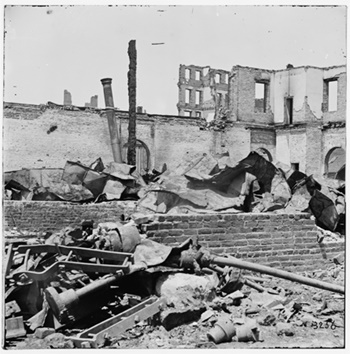
Civil War destruction.
The photograph at top left shows the ruins of the Richmond and Petersburg Railroad depot in Richmond.
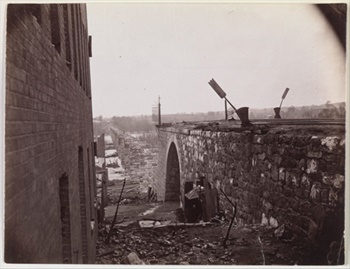
Bottom left is seen the ruins of the Richmond and Petersburg Rairoad bridge whose 2,850-foot wooden lattice superstructure was burned by retreating Confederate troops in 1865. It was rebuilt in 1866, but in 1882 it burned again. The squared granite piers seen here extending across the James River can still be seen today. Both images from the Library of Congress.
>Back to Top<
They Heard It on the Train
The "oration" delivered on the return trip to Richmond during the excursion celebrating the rebuilding and opening of the Richmond and Petersburg Railroad bridge over the James was reproduced in the 28 May 1866 Daily Dispatch. Although the journalist admits that the account is not given verbatim, it does illustrate a rather high level of celebratory cheer, or the effects of that cheer on the celebrants. It is not surprising that the "long rounds of applause ... nearly caused the 'Demosthenes of Manchester' to dive suddenly into the recesses of the barrel upon the top of which he had been speaking.
The original article occupied two columns in the paper. The clipping reproduced below took text from the two columns and combined them into a single column altered for reprinting. The content was not altered.
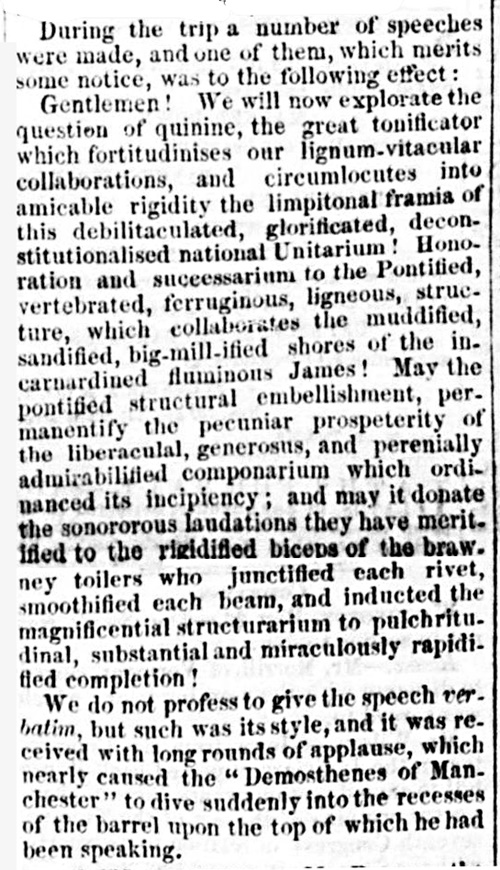
>Back to Top<
Could This Be the Henrico?
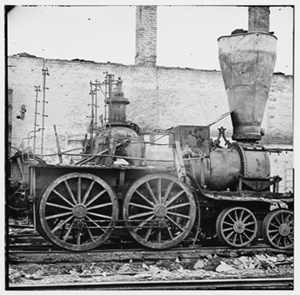
While there is no known photograph of the locomotive, Henrico, Marvin Broyhill in his The Antebellum Railroads of Petersburg, Virginia argues that the top left picture depicts the locomotive. Noting that the burned locomotive is in the ruins of the Petersburg and Richmond Railroad depot in Richmond, he then refers to the engraving in bottom left from the 13 December 1862 Harper's Weekly. It shows a freight train leaving Petersburg. He writes that Petersburg did not have coal, which was generally hauled by other locomotives, but had large gravel pits, of which the Henrico was a major carrier. He then points out the similarity of design between the photographed locomotive and the one in the engraving. It might take a significant leap of faith to embrace the identification, but it is interesting to consider. To learn more of the railroad line and others, checkout Bryoyhill's article at www.petersburg-parks.com, and also sonofthesouth.net.
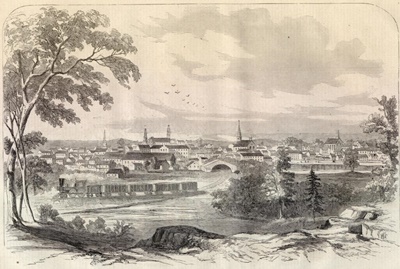
>Back to Top<
Correction
We thank Art Taylor, great-great-grandson of George Watt, for his advising us of an error in the article about Watt in the last issue. We indicated that the 1840 census found George Watt living in Richmond Ward 1, Henrico County. The George Watt identified in the census, however, was the uncle of the inventor of the Watt Cuff and Brace Plow, who was still in Alabama in 1840. We appreciate the information and invite our readers to visit www.wattplow.com, Taylor's website, which we found most helpful and believe you will find quite interesting!
>Back to Top<
Now You Know
This coffee roaster could make the user hot & cranky.

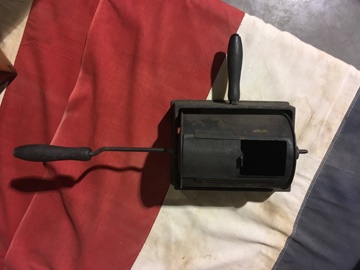
Congratulations to Haywood and Mary Jo Wigglesworth for identifying the object seen in the two photos at the left as a coffee roaster.
While we can buy our coffee already roasted and even ground, earlier coffee drinkers had a bit more to do to get their caffeine fixes. They took the green coffee beans, loaded them in the drum of the roaster, closed it, and set the roaster on top of the stove.
There was also a roaster like the one below right for the fireplace where the canister was on a long rod with a wooden handle. Tee extension of the rod at the end could be rested on something in the fireplace while the user spun the handle to prevent burning the beans.
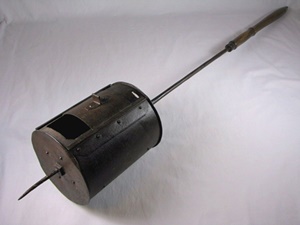
It was not always a pleasant activity, producing a good deal of smoke and sometimes an odor resembling burnt toast.
Roasted beans had to be ground and the device at the bottom left provided for that. The hinged metal cover was swung open as seen, beans were loaded and the cover was closed. Turning the crank ground the beans, and the ground coffee fell into the drawer at the bottom.
American thirst for coffee is great, and times of shortage have led to some interesting, though not particularly appetizing, substitutes.
Such was the case during the Civil War. Southerners were known to substitute chicory, acorns, beans, beets, corn, cotton seeds, dandelion root, okra seeds and more.

Confederate prisoners referred to substitute coffee as Lincoln coffee. In Portals To Hell, Lonnie R. Speer says it was what "any coffee made from substitutes was called. The boiling of parched corn, rye, and even wood splinters were several methods resorted to." This derogatory term referred to the belief that President Lincoln was responsible for the current state of affairs and what the prisoners had been reduced to.
A more pleasant version of coffee was offered by Mary Randolph in her The Virginia Housewife.
Coffee Cream
Toast two gills of raw coffee till it is a light brown, and not a grain burnt; put it hot from the toaster without grinding it, into a quart of rich, and perfectly sweet milk; boil it, and add the yelks of eight eggs; when done, strain it through a sieve, and sweeten it; if properly done, it will not be discoloured. The coffee may be dried, and will answer for making in the usual way to drink, allowing more for the quantity of water, than if it had not gone through this process.
Note: yelf was earlier an acceptable form of yolk.
>Back to Top<
What Do You Know?

The silver plated vessel pictured above has a hinged lid. It is 7 inchs tall, and the cork stopper in the neck has a small hole in it.
Do you know what it is?
Email your answers to jboehling@verizon.net.
If you have an unusual object that you think we might be interested in for this quarterly feature, let us know. We'd love to hear from you.
>Back to Top<
News 2019: First Quarter
Second Quarter | Third Quarter | Fourth Quarter
Home | Henrico | Maps | Genealogy | Preservation | Membership | Shopping | HCHS
|











